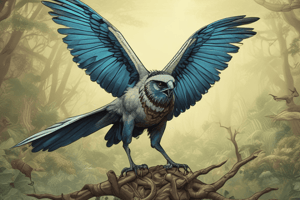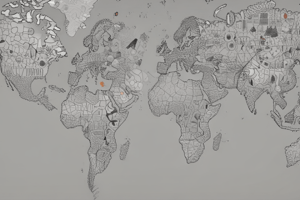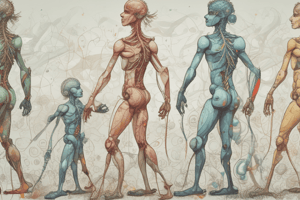Podcast
Questions and Answers
What are the consequences of mutations on phenotypes?
What are the consequences of mutations on phenotypes?
- Mutations can either be neutral, cause lethal diseases, or affect phenotypes differently. (correct)
- Mutations always cause changes in phenotypes.
- Mutations never affect the phenotypes.
- Only lethal diseases can be caused by mutations.
How does genetic recombination occur during sexual reproduction in humans?
How does genetic recombination occur during sexual reproduction in humans?
- One member of each chromosome pair is shuffled randomly into each egg and sperm. (correct)
- Genomes of both parents are mixed entirely at random without any specific mechanism.
- Each chromosome in humans is copied twice before being passed to offspring.
- All genes are recombined except for those on sex chromosomes.
What factor increases genetic variation by picking up a 'new' gene?
What factor increases genetic variation by picking up a 'new' gene?
- Lateral gene transfer (correct)
- Natural selection
- Genetic recombination
- Mutations
What primarily determines the number of phenotypes for a given trait?
What primarily determines the number of phenotypes for a given trait?
How can natural selection affect single-gene traits?
How can natural selection affect single-gene traits?
Which is NOT a way that reproductive isolation can develop?
Which is NOT a way that reproductive isolation can develop?
What is the primary result of reproductive isolation between two populations?
What is the primary result of reproductive isolation between two populations?
Which isolation occurred due to differences in courtship rituals in Darwin’s finches?
Which isolation occurred due to differences in courtship rituals in Darwin’s finches?
Which effect describes a change in allele frequencies due to the migration of a small subgroup?
Which effect describes a change in allele frequencies due to the migration of a small subgroup?
What type of isolation occurs when species reproduce at different times?
What type of isolation occurs when species reproduce at different times?
Which event is considered the initial step leading to speciation in the Galapagos finches?
Which event is considered the initial step leading to speciation in the Galapagos finches?
What can result in a dramatic reduction in genetic diversity?
What can result in a dramatic reduction in genetic diversity?
In which scenario is genetic equilibrium achieved?
In which scenario is genetic equilibrium achieved?
Which of the following best describes polygenic traits?
Which of the following best describes polygenic traits?
Which phenomenon can occur in small populations leading to changes in allele frequency by chance?
Which phenomenon can occur in small populations leading to changes in allele frequency by chance?
What does the gene pool of a population consist of?
What does the gene pool of a population consist of?
Which statement best describes how allele frequency changes in a population over time?
Which statement best describes how allele frequency changes in a population over time?
What does natural selection act upon in an organism?
What does natural selection act upon in an organism?
Which of the following is NOT a source of genetic variation?
Which of the following is NOT a source of genetic variation?
Which activities are directly responsible for generating variation in chromosomes?
Which activities are directly responsible for generating variation in chromosomes?
What role do Hox genes play in the development of an embryo?
What role do Hox genes play in the development of an embryo?
How does genetic rearrangement influence eukaryotic cells?
How does genetic rearrangement influence eukaryotic cells?
What factor contributed to the adaptation and natural selection of birds in the Galapagos Islands?
What factor contributed to the adaptation and natural selection of birds in the Galapagos Islands?
Which factor influenced the mutation variations among birds from different islands in the Galapagos?
Which factor influenced the mutation variations among birds from different islands in the Galapagos?
What is the purpose of a molecular clock in genetic studies?
What is the purpose of a molecular clock in genetic studies?
Why did birds from different islands in the Galapagos exhibit behavioral isolation?
Why did birds from different islands in the Galapagos exhibit behavioral isolation?
What can small changes in Hox gene activity during the embryological stage cause?
What can small changes in Hox gene activity during the embryological stage cause?
What is the significance of 'ticks' in the context of molecular clocks?
What is the significance of 'ticks' in the context of molecular clocks?
How does the degree of specialization in birds impact competition for resources?
How does the degree of specialization in birds impact competition for resources?
What is one way new genes can evolve according to molecular evolution?
What is one way new genes can evolve according to molecular evolution?
Flashcards are hidden until you start studying
Study Notes
Genes and Variations
- Genetic information is stored in chromosomes, which generate variation
- A gene pool consists of all genes present in a population
- Allele frequency is the number of times an allele occurs in a gene pool as a percentage of the total alleles for that gene
- Evolution involves any change in allele frequency in a population over time
- Genotype refers to an organism's genetic makeup, while phenotype refers to its physical characteristics
Sources of Genetic Variation
- Mutation: a heritable change in genetic information
- Genetic recombination during sexual reproduction: shuffling of genes during meiosis
- Lateral gene transfer: gene flow can increase genetic variation and introduce new genes
Single-Gene and Polygenic Traits
- Single-gene traits: controlled by one gene
- Polygenic traits: controlled by two or more genes
- Natural selection on single-gene traits can produce changes in allele frequencies reflected in phenotype frequencies
Genetic Drift and Bottlenecks
- Genetic drift: random change in allele frequency in small populations
- Founder effect: allele frequencies change due to migration of a small subgroup
- Genetic bottleneck: reduction in genetic diversity due to a dramatic decrease in population size
Speciation and Isolating Mechanisms
- Reproductive isolation: when two populations stop interbreeding altogether
- Behavioral isolation: differences in courtship rituals or behaviors
- Geographic isolation: separation by geographic barriers
- Temporal isolation: reproduction at different times
- Speciation in Darwin's finches: geographic isolation, changes in gene pool, behavioral isolation, and ecological competition
Molecular Evolution
- New genes can evolve through duplication and modification of existing genes
- Gene duplication: copy of a gene can mutate and take on a new function
- Genetic rearrangement: chromosomes can break and reconnect, acquiring new sequences of DNA
Developmental Genes and Body Plans
- Hox genes determine the body plan of an embryo
- Small changes in hox gene activity during embryological stage can produce big changes in adult animals
Molecular Clocks and Neutral Mutations
- Molecular clock: uses mutation rates in DNA to estimate time of independent evolution
- Ticks: measure the number of mutations that occur in a human body over time
Studying That Suits You
Use AI to generate personalized quizzes and flashcards to suit your learning preferences.




